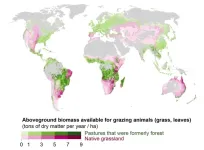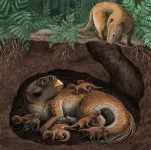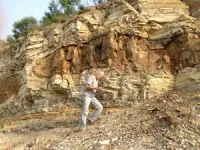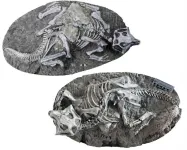(Press-News.org) Scientists and environmental activists have consistently called for drastic reductions in meat production as a way to reduce emissions and, in doing so, combat climate change. However, a new analysis concludes that a smaller reduction, borne by wealthier nations, could remove 125 billion tons of carbon dioxide—exceeding the total number of global fossil fuel emissions over the past three years—from the atmosphere.
Small cutbacks in higher-income countries—approximately 13% of total production—would reduce the amount of land needed for cattle grazing, the researchers note, allowing forests to naturally regrow on current pastureland. The return of trees—long known to effectively absorb, or sequester, carbon dioxide (CO2)—would drive significant declines in fossil fuel emissions, which the study’s authors estimate would roughly equal three years’ worth of global emissions.
“We can achieve enormous climate benefits with modest changes to the total global beef production,” says Matthew N. Hayek, an assistant professor in New York University’s Department of Environmental Studies and the lead author of the analysis, which appears in the journal Proceedings of the National Academy of Sciences (PNAS). “By focusing on regions with potentially high carbon sequestration in forests, some restoration strategies could maximize climate benefits while minimizing changes to food supplies.”
The analysis found that pasturelands, especially in areas that were once forests, hold immense promise for mitigating climate change. When livestock are removed from these “potential native forest” areas, ecosystems can revert to their natural forested state, capturing carbon in trees and soil.
The paper’s authors see high- and upper-middle-income countries as viable candidates for reduction in beef production because they have some current pasture areas that do not produce very much grass per acre, exist where grass grows only during a short growing season, and are in areas that could, instead, grow vast, lush forests with deep soils that work to sequester carbon. This differs significantly from other regions, including sub-Saharan Africa and South America, where much more pasture can grow year-round, producing more feed for animals per acre than northern countries. In addition, the research team sees ways lower-income regions could increase the efficiency at which cattle are fed and raised on grass as a way to offset the minor loss in production from higher-income countries.
“This isn’t a one-size-fits-all solution,” Hayek emphasizes. “Our findings show that strategic improvements in the efficiency of cattle herds in some areas, coupled with decreased production in others, could lead to a win-win scenario for climate and food production.”
The study reveals an even more dramatic potential for climate mitigation if the scope of restoration was expanded. The researchers found that removing cattle, sheep, and other grazing livestock from all potentially natively forested areas globally could sequester a staggering 445 gigatons of CO2 by the end of this century—the equivalent to more than a decade of current global fossil fuel emissions.
“Importantly, this approach would still allow livestock grazing to remain on native grasslands and dry rangelands, which are places where crops or forests cannot easily grow,” says Hayek. “These areas support more than half of global pasture production, meaning that this ambitious forest restoration scenario would require cutting global cattle, sheep, and other livestock herds by less than half. These findings underscore the immense potential of natural forest restoration as a climate solution.”
The PNAS study used remote sensing technology to track pasture productivity—the amount of grass produced annually that livestock can consume—in order to estimate the climate benefits that reductions would yield.
“Even if two different areas can regrow the same amount of carbon in trees, we can now know how much pasture, hence beef production, we would have to lose in each area to grow those trees back,” explains Johannes Piipponen, a doctoral candidate at Finland’s Aalto University and coauthor of the study, who led this technical advance. “For many consumers in high-income regions, like Europe and North America, reducing excessive meat consumption benefits both their health and the environment. However, until now, it has remained rather unclear where the required decreases in production could begin.”
Maps produced by the team’s research can identify areas where policies could be prioritized for reducing beef production and hastening forest recovery—for instance, by offering forest land conservation incentives or buyouts to beef producers.
The authors acknowledge that ecosystem regrowth is not a substitute for efforts to reduce fossil fuel emissions. But, it can serve as a powerful complement to combat climate change.
“In many places, this regrowth could occur by seeds naturally dispersing and trees regrowing without any human involvement,” says Hayek. “However, in some places, with especially degraded environments or soils, native and diverse tree-planting could accelerate forest restoration, giving regrowth a helping hand. This long-term regrowth would benefit the climate for decades to come, with significant regrowth and carbon capture beginning within just a few years in many areas, and lasting for 75 years or more until forests nearly mature.”
The authors also emphasize that while the findings do not call for extreme changes to global food production and trade patterns, swift action is necessary in order to meet climate goals.
“Within the next two decades, countries are aiming to meet critical climate mitigation targets under international agreements, and ecosystem restoration on converted pasturelands can be a critical part of that,” observes Hayek. “Our study’s findings could offer paths forward for policymakers aiming to address both climate mitigation and food security concerns. As countries worldwide commit to ambitious reforestation targets, we hope that this research can help identify and prioritize the most effective areas for carbon sequestration efforts while considering global food needs.”
# # #
END
Small reductions to meat production in wealthier countries may help fight climate change, new analysis concludes
Eliminating fraction of current beef production could remove three years’ worth of global fossil fuel emissions
2024-11-04
ELSE PRESS RELEASES FROM THIS DATE:
Scientists determine why some patients don’t respond well to wet macular degeneration treatment, show how new experimental drug can bridge gap
2024-11-04
**EMBARGOED FOR RELEASE UNTIL NOV. 4 AT 3:00 P.M. EST**
A new study from researchers at Wilmer Eye Institute, Johns Hopkins Medicine explains not only why some patients with wet age-related macular degeneration (or “wet” AMD) fail to have vision improvement with treatment, but also how an experimental drug could be used with existing wet AMD treatments to save vision.
Wet AMD, one of two kinds of AMD, is a progressive eye condition caused by an overgrowth of blood vessels in the retina, the light-sensing tissue in ...
Did the world's best-preserved dinosaurs really die in 'Pompeii-type' events?
2024-11-04
Between about 120 million and 130 million years ago, during the age of dinosaurs, temperate forests and lakes hosted a lively ecosystem in what is now northeast China. Diverse fossils from that time remained pretty much undisturbed until the 1980s, when villagers started finding exceptionally preserved creatures, which fetched high prices from collectors and museums. This started a fossil gold rush. Both locals and scientists have now dug so much, their work can be seen from space―perhaps the most extensive paleontological excavations anywhere.
By the 1990s, it was clear that the so-called Yixian ...
Not the usual suspects: Novel genetic basis of pest resistance to biotech crops
2024-11-04
If left unchecked, insect pests can devastate crops. To minimize damage and reduce the need for insecticide sprays, crops have been genetically engineered to produce bacterial proteins that kill key pests but are not harmful to people or wildlife. However, widespread planting of such transgenic crops has led to rapid adaptation by some pests. A new study in the Proceedings of the National Academy of Sciences reveals a novel genetic basis of resistance to transgenic crops in one of the most important crop pests in the United States.
Researchers from the University of Arizona Department of Entomology in the College of Agriculture, Life and Environmental Sciences used genomics to investigate the ...
Jill Tarter to receive Inaugural Tarter Award for Innovation in the search for life beyond earth
2024-11-04
Jill Tarter to Receive Inaugural Tarter Award for Innovation in the Search for Life Beyond Earth
November 4, 2024, Mountain View, CA – Renowned astronomer, Dr. Jill Tarter, SETI Institute co-founder and pioneering SETI researcher, will be honored with the inaugural Tarter Award for Innovation in the Search for Life Beyond Earth at the SETI Institute’s 40th Anniversary celebration on November 20, 2024, in Menlo Park, CA. This new award recognizes individuals whose projects or ideas significantly advance humanity’s search for extraterrestrial life and intelligence. The Tarter Award honors contributions ...
Survey finds continued declines in HIV clinician workforce
2024-11-04
November 4, 2024 — The supply of healthcare professionals available to provide HIV care continues to decline, even as the need for HIV care and prevention is expected to increase, reports a survey study in the November/December issue of The Journal of the Association of Nurses in AIDS Care (JANAC). The official journal of the Association of Nurses in AIDS Care, JANAC is published in the Lippincott portfolio by Wolters Kluwer.
"Our study provides new insights into the numbers and characteristics of clinicians who will be available to provide HIV care in the coming years. This information ...
Researchers home in on tumor vulnerabilities to improve odds of treating glioblastoma
2024-11-04
A team led by researchers at the University of Toronto has uncovered new targets that could be the key to effectively treating glioblastoma, a lethal type of brain cancer. These targets were identified through a screen for genetic vulnerabilities in patient-derived cancer stem cells that represent the variability found in tumours.
Glioblastoma is the most common type of brain cancer in adults. It is also the most challenging to treat due to the resistance of glioblastoma cancer stem cells, from which tumours grow, to therapy. Cancer stem cells that survive after a tumour is treated go on to form new tumours that do not respond to further treatment.
“Glioblastoma tumors have ...
Awareness of lung cancer screening remains low
2024-11-04
There is a lung cancer screening test that is saving lives – and yet most people who could be getting the test have never heard of it or never talked about it with a doctor.
“We’ve got a screening test that works. It works as well, if not better, than breast and colorectal cancer screening in terms of mortality reduction. It's one of the most life-saving things we have for a cancer that kills more people than either of those two combined,” said lung cancer pulmonologist Gerard Silvestri, M.D. And yet, he said, “Eighty percent of those eligible for this screening, regardless of race, education, ethnicity, health or income, hadn’t heard of or ...
Hospital COVID-19 burden and adverse event rates
2024-11-04
About The Study: In this cohort study of hospital admissions among Medicare patients during the COVID-19 pandemic, greater hospital COVID-19 burden was associated with an increased risk of in-hospital adverse effects among both patients with and without COVID-19. These results illustrate the need for greater hospital resilience and surge capacity to prevent declines in patient safety during surges in demand.
Corresponding Author: To contact the corresponding author, Mark L. Metersky, MD, email metersky@uchc.edu.
To access the embargoed study: Visit our For The Media website at this link https://media.jamanetwork.com/
(doi:10.1001/jamanetworkopen.2024.42936)
Editor’s ...
NSF NOIRLab astronomers discover the fastest-feeding black hole in the early universe
2024-11-04
Supermassive black holes exist at the center of most galaxies, and modern telescopes continue to observe them at surprisingly early times in the Universe’s evolution. It’s difficult to understand how these black holes were able to grow so big so rapidly. But with the discovery of a low-mass supermassive black hole feasting on material at an extreme rate, seen just 1.5 billion years after the Big Bang, astronomers now have valuable new insights into the mechanisms of rapidly growing black holes in the early Universe.
LID-568 was discovered ...
Translational science reviews—a new JAMA review
2024-11-04
About The Article: To help clinicians keep up with ongoing basic and translational science discoveries that affect the diagnosis and treatment of human disease, JAMA has launched a new series, “Translational Science Reviews.” These new article types are succinct and informative summaries of important basic science advances that are transforming diagnosis and treatment of human disease.
Corresponding Author: To contact the corresponding author, Mary M. McDermott, MD, email mdm608@northwestern.edu.
To access the embargoed study: Visit our For The Media website at this link https://media.jamanetwork.com/
(doi:10.1001/jama.2024.21146)
Editor’s Note: Please ...
LAST 30 PRESS RELEASES:
On-demand upgraded recycling of polyethylene and construction of sustainable multifunctional materials based on the "LEGO" strategy
New "Stomata in-sight" system allows scientists to watch plants breathe in real-time
Anorexia nervosa may result in long-term skeletal muscle impairment
Narrative-based performance reviews deemed fairest by employees
New insights reveal how advanced oxidation can tackle emerging water pollutants
New review shows how biomass can deliver low-carbon gaseous fuels at scale
Climate change is quietly rewriting the world’s nitrogen cycle, with high stakes for food and the environment
Study finds SGLT-2 inhibitors linked to lower risk of diabetic foot nerve damage
Microbes may hold the key to brain evolution
Study examines how the last two respiratory pandemics rapidly spread through cities
Gender stereotypes reflect the division of labor between women and men across nations
Orthopedics can play critical role in identifying intimate partner violence
Worms as particle sweepers
Second spider-parasitic mite described in Brazil
January 2026 issues of APA journals feature new research on autism, pediatric anxiety, psychedelic therapy, suicide prevention and more
Private equity acquired more than 500 autism centers over the past decade, new study shows
New cervical cancer screening guidelines from the US Department of Health and Human Services
Estimated burden of COVID-19 illnesses, medical visits, hospitalizations, and deaths in the US from October 2022 to September 2024
Smartphone use during school hours by US youth
Food insecurity and adverse social conditions tied to increased risk of long COVID in children
Earliest, hottest galaxy cluster gas on record could change our cosmological models
Greenland’s Prudhoe Dome ice cap was completely gone only 7,000 years ago, first GreenDrill study finds
Scientific validity of blue zones longevity research confirmed
Injectable breast ‘implant’ offers alternative to traditional surgeries
Neuroscientists devise formulas to measure multilingualism
New prostate cancer trial seeks to reduce toxicity without sacrificing efficacy
Geometry shapes life
A CRISPR screen reveals many previously unrecognized genes required for brain development and a new neurodevelopmental disorder
Hot flush treatment has anti-breast cancer activity, study finds
Securing AI systems against growing cybersecurity threats
[Press-News.org] Small reductions to meat production in wealthier countries may help fight climate change, new analysis concludesEliminating fraction of current beef production could remove three years’ worth of global fossil fuel emissions







